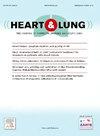Associations and mediating mechanisms between lung cancer and chronic comorbidities: a matched case-control study
IF 2.6
4区 医学
Q2 CARDIAC & CARDIOVASCULAR SYSTEMS
引用次数: 0
Abstract
Background
Respiratory and cardio-cerebrovascular comorbidities are common in patients with lung cancer (LC), yet their clinical correlates and potential mediating mechanisms remain poorly understood.
Objectives
This study investigates the associations between respiratory and cardio-cerebrovascular comorbidities and LC and explores subtype-specific tumor biomarkers.
Methods
A 1:1 matched case-control study was conducted at Qilu Hospital of Shandong University from April 2023 to March 2024. Conditional logistic regression models, adjusted for potential confounders, and causal mediation analysis were used to assess the associations and mediating pathways between chronic comorbidities and LC, including subtype-specific tumor biomarkers. Comorbidity data and blood biomarkers were extracted from electronic medical records.
Results
Respiratory and cardio-cerebrovascular comorbidities were significantly associated with LC (model 4: p = 0.029 and p = 0.045). After adjustment for the total number of chronic comorbidities, these associations were no longer significant (model 5: p = 0.507 and p = 0.875). Lymphocyte percentage (Lym %) and d-dimer (DDi) partially mediated both associations (single-mediator models: all p < 0.05). CYFRA21–1 was linked to respiratory comorbidities (p = 0.001), whereas PRO-GRP was associated with cardio-cerebrovascular comorbidities (p = 0.031), indicating subtype-specific patterns related to non-small-cell lung cancer (NSCLC) and small-cell lung cancer (SCLC).
Conclusions
LC is associated with both respiratory and cardio-cerebrovascular comorbidities, and immune- and coagulation-related biomarkers may partially mediate these associations. Total comorbidity burden shows a stronger association with LC risk than any individual comorbidity, underscoring the value of incorporating comorbidity assessment into LC risk evaluation.
肺癌和慢性合并症之间的关联和中介机制:一项匹配的病例对照研究
肺癌(LC)患者常见呼吸和心脑血管合并症,但其临床相关性和潜在的介导机制尚不清楚。目的探讨呼吸和心脑血管合并症与LC的关系,并探索亚型特异性肿瘤生物标志物。方法于2023年4月至2024年3月在山东大学齐鲁医院进行1:1配对病例对照研究。使用条件逻辑回归模型,调整潜在混杂因素,以及因果中介分析来评估慢性合并症与LC之间的关联和中介途径,包括亚型特异性肿瘤生物标志物。从电子病历中提取共病数据和血液生物标志物。结果呼吸和心脑血管合并症与LC有显著相关性(模型4:p = 0.029和p = 0.045)。在调整了慢性合并症的总数后,这些关联不再显著(模型5:p = 0.507和p = 0.875)。淋巴细胞百分比(Lym %)和d-二聚体(DDi)部分介导了这两种关联(单介质模型:所有p <;0.05)。CYFRA21-1与呼吸合并症相关(p = 0.001),而PRO-GRP与心脑血管合并症相关(p = 0.031),表明与非小细胞肺癌(NSCLC)和小细胞肺癌(SCLC)相关的亚型特异性模式。结论slc与呼吸和心脑血管合并症相关,免疫和凝血相关生物标志物可能在一定程度上介导了这些关联。总的共病负担与LC风险的相关性强于任何单个共病,这强调了将共病评估纳入LC风险评估的价值。
本文章由计算机程序翻译,如有差异,请以英文原文为准。
求助全文
约1分钟内获得全文
求助全文
来源期刊

Heart & Lung
医学-呼吸系统
CiteScore
4.60
自引率
3.60%
发文量
184
审稿时长
35 days
期刊介绍:
Heart & Lung: The Journal of Cardiopulmonary and Acute Care, the official publication of The American Association of Heart Failure Nurses, presents original, peer-reviewed articles on techniques, advances, investigations, and observations related to the care of patients with acute and critical illness and patients with chronic cardiac or pulmonary disorders.
The Journal''s acute care articles focus on the care of hospitalized patients, including those in the critical and acute care settings. Because most patients who are hospitalized in acute and critical care settings have chronic conditions, we are also interested in the chronically critically ill, the care of patients with chronic cardiopulmonary disorders, their rehabilitation, and disease prevention. The Journal''s heart failure articles focus on all aspects of the care of patients with this condition. Manuscripts that are relevant to populations across the human lifespan are welcome.
 求助内容:
求助内容: 应助结果提醒方式:
应助结果提醒方式:


